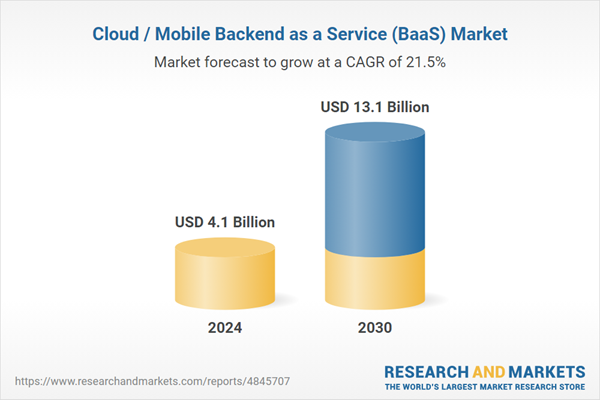Global Cloud / Mobile Backend as a Service (BaaS) Market - Key Trends and Drivers Summarized
Why Is Cloud/Mobile Backend as a Service (BaaS) Gaining Traction?
Cloud/Mobile Backend as a Service (BaaS) is rapidly gaining traction in the app development landscape due to its ability to simplify backend management and speed up the development process. Traditionally, developers had to manage complex backend infrastructures, dealing with server management, database setup, user authentication, and other foundational elements. With BaaS, all of these backend services are abstracted and provided through cloud-based platforms, allowing developers to focus on building frontend features and enhancing user experiences. This model significantly reduces time-to-market, especially for mobile apps, which need to be agile in responding to user demands and market trends. BaaS platforms offer scalable backend solutions, enabling developers to handle user authentication, push notifications, database management, and cloud storage without the need for extensive infrastructure management. As mobile applications grow more sophisticated and consumer expectations rise, BaaS provides a flexible, cost-effective solution for startups and enterprises alike, allowing them to rapidly deploy apps while minimizing backend complexity and overhead. The ability to integrate seamlessly with third-party APIs further enhances the appeal of BaaS, providing a wide array of functionalities like social media integration, payment gateways, and analytics, all essential for modern app development.How Are Technological Advancements Driving the Adoption of BaaS?
Technological advancements are playing a significant role in accelerating the adoption of Cloud/Mobile BaaS solutions. The rise of serverless computing and microservices architectures has made BaaS platforms even more appealing to developers by reducing the need for managing physical or virtual servers. With serverless models, developers can run functions on-demand in a highly scalable environment, where resources are allocated dynamically, and the need for upfront provisioning is eliminated. This allows businesses to pay only for the resources they use, leading to greater cost-efficiency and scalability. Additionally, as the Internet of Things (IoT) and mobile devices proliferate, applications require more complex backend systems capable of handling massive amounts of data in real time. BaaS platforms provide robust infrastructure that supports these high-demand environments, making it easier to manage data from connected devices. Furthermore, the growth of artificial intelligence (AI) and machine learning (ML) is influencing the BaaS ecosystem by enabling the integration of AI-driven functionalities into mobile apps, such as voice recognition, chatbots, and predictive analytics. These emerging technologies are enhancing the capabilities of BaaS platforms, allowing developers to build smarter, more responsive applications without needing specialized AI or ML expertise. By leveraging BaaS, businesses can innovate faster and integrate cutting-edge technologies more seamlessly into their mobile ecosystems.Why Are Enterprises and Startups Turning to BaaS for Mobile App Development?
Enterprises and startups alike are increasingly adopting Cloud/Mobile Backend as a Service (BaaS) due to the efficiency and scalability it offers for mobile app development. In an era where mobile applications are central to business strategies, the ability to build, deploy, and maintain apps quickly is crucial. BaaS allows companies to eliminate much of the backend complexity involved in app development, providing a suite of pre-built services that handle everything from user authentication and data storage to push notifications and social media integration. For startups, BaaS provides a vital opportunity to launch mobile apps rapidly and cost-effectively without having to invest in large IT teams or infrastructure, allowing them to focus resources on innovation and market growth. Enterprises, on the other hand, leverage BaaS to scale their mobile operations, especially when managing multiple applications or dealing with fluctuating user demand. The flexibility of BaaS also enables businesses to pivot quickly, adding new features or scaling resources as their apps evolve. Furthermore, the growing importance of cross-platform development - building apps that work seamlessly across iOS, Android, and web environments - is another factor driving BaaS adoption. Many BaaS platforms are designed to simplify cross-platform development, offering tools that allow developers to write code once and deploy it across multiple platforms, which saves time and resources.What Factors Are Fueling Expansion of the Cloud/Mobile BaaS Market?
The growth in the Cloud/Mobile Backend as a Service (BaaS) market is driven by several key factors, including the increasing demand for mobile and web applications, the need for faster app development cycles, and the growing reliance on cloud infrastructure. One of the primary drivers is the explosive growth in mobile device usage, which has led to a corresponding rise in the number of apps being developed across various industries. Businesses are under pressure to release apps quickly and frequently update them with new features to stay competitive, making BaaS a crucial tool for accelerating development timelines. Another significant driver is the shift towards cloud-native application development, where BaaS provides the perfect complement to cloud computing by offering scalable, on-demand backend services that align with cloud-first strategies. The growing adoption of serverless architectures is also fueling the demand for BaaS solutions, as they allow developers to focus solely on application logic without worrying about underlying infrastructure management. In addition, consumer expectations for seamless, real-time experiences are pushing businesses to integrate features like push notifications, real-time data sync, and user analytics into their apps, all of which are easily managed through BaaS platforms. The rise of the Internet of Things (IoT) is further driving the need for scalable backend services, as apps must now handle data from a wide array of connected devices. Lastly, the increasing emphasis on user experience, combined with the rapid pace of technological advancements such as 5G and AI, is propelling businesses to adopt BaaS solutions that allow for quick integration of advanced features, enabling them to deliver more personalized and interactive mobile experiences. These factors are contributing to the strong growth trajectory of the Cloud/Mobile BaaS market as more businesses adopt mobile-first strategies and seek efficient ways to manage their backend infrastructure.Report Scope
The report analyzes the Cloud / Mobile Backend as a Service (BaaS) market, presented in terms of market value (USD). The analysis covers the key segments and geographic regions outlined below.- Segments: Service (Usage Analytics, Data Integration, Identity & Access Management, Other Services); Operating System (Android, iOS, Other Operating Systems); Vertical (BFSI, Retail & Wholesale, IT & Telecom, Manufacturing, Media, Entertainment & Gaming, Other Verticals).
- Geographic Regions/Countries: World; United States; Canada; Japan; China; Europe (France; Germany; Italy; United Kingdom; and Rest of Europe); Asia-Pacific; Rest of World.
Key Insights:
- Market Growth: Understand the significant growth trajectory of the Usage Analytics segment, which is expected to reach US$5.9 Billion by 2030 with a CAGR of 24.3%. The Data Integration segment is also set to grow at 18.6% CAGR over the analysis period.
- Regional Analysis: Gain insights into the U.S. market, valued at $1.1 Billion in 2024, and China, forecasted to grow at an impressive 20.2% CAGR to reach $2 Billion by 2030. Discover growth trends in other key regions, including Japan, Canada, Germany, and the Asia-Pacific.
Why You Should Buy This Report:
- Detailed Market Analysis: Access a thorough analysis of the Global Cloud / Mobile Backend as a Service (BaaS) Market, covering all major geographic regions and market segments.
- Competitive Insights: Get an overview of the competitive landscape, including the market presence of major players across different geographies.
- Future Trends and Drivers: Understand the key trends and drivers shaping the future of the Global Cloud / Mobile Backend as a Service (BaaS) Market.
- Actionable Insights: Benefit from actionable insights that can help you identify new revenue opportunities and make strategic business decisions.
Key Questions Answered:
- How is the Global Cloud / Mobile Backend as a Service (BaaS) Market expected to evolve by 2030?
- What are the main drivers and restraints affecting the market?
- Which market segments will grow the most over the forecast period?
- How will market shares for different regions and segments change by 2030?
- Who are the leading players in the market, and what are their prospects?
Report Features:
- Comprehensive Market Data: Independent analysis of annual sales and market forecasts in US$ Million from 2024 to 2030.
- In-Depth Regional Analysis: Detailed insights into key markets, including the U.S., China, Japan, Canada, Europe, Asia-Pacific, Latin America, Middle East, and Africa.
- Company Profiles: Coverage of players such as Built.Io, Cloudmine Inc., IBM Corporation, Kii Corporation, Kinvey, Inc. and more.
- Complimentary Updates: Receive free report updates for one year to keep you informed of the latest market developments.
Some of the 18 companies featured in this Cloud / Mobile Backend as a Service (BaaS) market report include:
- Built.Io
- Cloudmine Inc.
- IBM Corporation
- Kii Corporation
- Kinvey, Inc.
- Kony
- Microsoft Corporation
- Oracle Corporation
This edition integrates the latest global trade and economic shifts into comprehensive market analysis. Key updates include:
- Tariff and Trade Impact: Insights into global tariff negotiations across 180+ countries, with analysis of supply chain turbulence, sourcing disruptions, and geographic realignment. Special focus on 2025 as a pivotal year for trade tensions, including updated perspectives on the Trump-era tariffs.
- Adjusted Forecasts and Analytics: Revised global and regional market forecasts through 2030, incorporating tariff effects, economic uncertainty, and structural changes in globalization. Includes historical analysis from 2015 to 2023.
- Strategic Market Dynamics: Evaluation of revised market prospects, regional outlooks, and key economic indicators such as population and urbanization trends.
- Innovation & Technology Trends: Latest developments in product and process innovation, emerging technologies, and key industry drivers shaping the competitive landscape.
- Competitive Intelligence: Updated global market share estimates for 2025, competitive positioning of major players (Strong/Active/Niche/Trivial), and refined focus on leading global brands and core players.
- Expert Insight & Commentary: Strategic analysis from economists, trade experts, and domain specialists to contextualize market shifts and identify emerging opportunities.
Table of Contents
Companies Mentioned (Partial List)
A selection of companies mentioned in this report includes, but is not limited to:
- Built.Io
- Cloudmine Inc.
- IBM Corporation
- Kii Corporation
- Kinvey, Inc.
- Kony
- Microsoft Corporation
- Oracle Corporation
Table Information
| Report Attribute | Details |
|---|---|
| No. of Pages | 182 |
| Published | December 2025 |
| Forecast Period | 2024 - 2030 |
| Estimated Market Value ( USD | $ 4.1 Billion |
| Forecasted Market Value ( USD | $ 13.1 Billion |
| Compound Annual Growth Rate | 21.5% |
| Regions Covered | Global |









